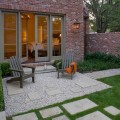Formal Italian Garden
The intent of a formal Italian garden is to settle the mind of the viewer and create a feeling of ease, contentment, and peace. Historically, gardens were planted Italy to be an extension of the home itself, and in many cases, a veritable outside room connected to the house. Today, not all Italian gardens are actually installed adjacent to the home, but all are built with a view of the house in mind, or built to be viewed from an ideal vantage point within the house.
A formal Italian garden is something that is created for people to enter, sit in and walk through. Outdoor rooms are made within the garden where benches, small patios, and picnic areas can be furnished with benches and outdoor furniture. Masonry walls, porticos, pergolas, grottos, and loggias work to subdivide Italian gardens into these special rooms of interest. Sometimes a garden pergola is built to create a sheltering enclosure that provides a special view of the home and surrounding Houston landscape.
Walkways can be made of cobblestone, ornamental stepping stone, or brick. This adds distinctively Old World flair to the garden and creates in invitation to tour its interior. These linear pathways are normally edged with low-growth evergreen shrubs to generate a feeling of organic softness in one’s surroundings.
Some of the species of shrubs that are used to line garden walkways include False Cypress, Russian Arborvitae, Blue Nest Spruce, Dwarf Spruce, and Little Gem Bird’s Nest Spruce. Larger formal Italian gardens can also have evergreen trees, such as Cypress or Poplar, to add vertical impact to their outdoor rooms.
To create geometry within the garden interior, evergreen shrubs are clipped into the forms of recognizable geometric shapes. Linearity is emphasized in every formal Italian garden, but there is also a near-equal or even equal emphasis placed on arcs and radii in the forms of spiral arms and spheres.
These shrubs are placed within planters or containers of some sort to lend symmetry and an obvious, but not to strict, sense of discipline to the garden. Evergreens are also grown and trimmed low to the ground to create these linear hedges and boundaries for geometric garden rooms.
Flowers, while not the essence of an Italian formal garden’s tones and hues, are always used to add color and special interest to various points throughout the interior. Urns are a popular way of showcasing flowers. These can be mounted on pedestals so they can enjoy an elevated position among the hedges. Most formal Italian gardens place them at eye height.
To give thematic unity to the garden, we recommend having all one color of flowers in all of the urns so as to link them together visually. Urns can also be planted with climbing vines right around the interior rim so the greenery grows down over the sides of the urns and cover them with green.
Centerpoints are essential to all formal gardens. Statues are almost always used as focal points in formal Italian gardens. This tradition is universal throughout Italian history, and dates back to Classical times.
When it comes to iconography, there is no such thing as a formal Italian garden without a classical sculpture. Due to the rich history of Italy and the many traditions that have formed its aesthetics, sculptures can appear Greek, Roman, or Renaissance in style and still provide an appropriate centerpoint for the garden’s geometry and color tones.
Statues are also used in isolated areas to create special interest, and they are sometimes used as well to center focus within interior garden rooms. A good way to showcase a statue is to build marble benches in a courtyard style around the icon. Some clients of ours, though, prefer to have a fountain as a centerpoint of a seating area, so a classical fountain can be substituted in these instances.
In Italy, water has always been always been a symbol for coolness. Since pre-Roman Etruscan times, manmade water features have defined Italian culture. Fountains were used to imitate the sounds of moving natural water, while reflecting pools were used as mirrors of consciousness. Today’s Italian garden can incorporate any of these motifs of antiquity to create sense and sensibility within the greenery.

